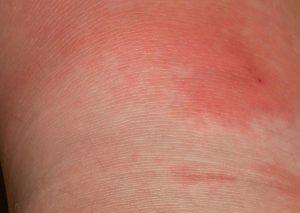Summary
Prickly heat, medically known as miliaria rubra, prickly heat, or heat rash, is one of the most common skin conditions affecting individuals. It is easily identifiable by the presence of small bumps that may contain fluid. This condition typically causes intense itching and, at times, a sensation as if tiny needles are pricking the skin.
Prickly heat occurs when the sweat ducts become blocked, preventing sweat from reaching the skin’s surface. This obstruction leads to the accumulation of sweat beneath the skin, creating an environment conducive to irritation and inflammation. As a result, prickly heat is more prevalent in people who are frequently exposed to the sun or those living in hot and humid environments. It commonly affects the skin on the face, neck, shoulders, and chest. Children are more susceptible to prickly heat than adults due to their higher sweat production and thinner skin.
Symptoms of prickly heat include the development of white or sometimes red bumps on the skin. Additionally, individuals with prickly heat may experience discomfort due to itching or burning sensations caused by the condition. These symptoms are often exacerbated by continued sweating and friction from clothing, which can further irritate the affected areas.
Prickly heat often resolves on its own within a few days as the sweat ducts clear and normal sweating resumes. However, various types of topical medications are available to alleviate the itching and discomfort associated with this condition. Cooling lotions, calamine, and antihistamines can provide symptomatic relief, while keeping the skin cool and dry helps prevent recurrence.
Table of Contents
Symptoms of Prickly Heat

Prickly heat, also known as miliaria rubra, prickly heat, or heat rash, manifests in various forms, each with its distinct features. However, all types share common symptoms. Some of these symptoms include:
- Presence of Red Bumps on the Skin. Red bumps may develop on the affected areas, indicating inflammation and irritation caused by blocked sweat ducts.
- Intense Itching Sensation on the Skin. One of the most prevalent symptoms, this itching can be severe and is often exacerbated by heat and sweating, leading to significant discomfort.
- Swelling of the Affected Areas of the Skin. Inflammation can result in mild swelling in the areas where sweat ducts are obstructed, contributing to the overall discomfort.
- Mild Burning Sensation on the Affected Areas of the Skin. A slight burning feeling may accompany the itching, further irritating the skin and adding to the discomfort.
- Irritability (Especially in Infants). Infants and young children may become irritable due to the constant discomfort and itching caused by prickly heat, affecting their overall mood and behavior.
Recognizing these symptoms early is crucial for effective management and treatment of prickly heat. If you or someone you know is experiencing these symptoms, taking immediate steps to cool the skin and reduce sweating can provide relief and prevent the condition from worsening.
Types of Prickly Heats
Prickly heat, also known as heat rash, comes in three primary types, each with distinct characteristics:
- Miliaria Crystallina. This is the most common and mildest form of prickly heat. It is characterized by tiny, clear or white bumps filled with sweat on the surface of the skin. These bumps are usually not itchy or painful and are more commonly seen in infants due to their underdeveloped sweat ducts. Miliaria crystallina often resolves on its own without causing significant discomfort.
- Miliaria Rubra (Prickly Heat). Also referred to as classic prickly heat, this type occurs deeper in the outer layer of the skin (epidermis). It is characterized by red, inflamed, and itchy bumps that can cause a prickling or stinging sensation. The affected skin may also feel hot and appear swollen. In this condition, sweat is trapped deeper in the skin, leading to irritation and inflammation. If left untreated, the bumps may develop into pustules due to secondary bacterial infection.
- Miliaria Profunda. This is the least common but more severe form of prickly heat. It develops in the deeper layers of the skin (dermis) and is characterized by larger, firm, and flesh-colored bumps. Unlike other types, miliaria profunda can cause more significant discomfort, as sweat glands become blocked at a deeper level, potentially leading to reduced sweating and heat intolerance.
Understanding these types of prickly heat can help in identifying the condition’s severity and choosing appropriate treatments. While mild forms like miliaria crystallina may resolve on their own, more severe cases like miliaria rubra or miliaria profunda may require intervention to relieve symptoms and prevent complications.
Diagnostic Procedures for Prickly Heat
Diagnosing prickly heat, also known as heat rash or miliaria, typically involves a straightforward evaluation due to its characteristic appearance. However, a healthcare professional may take certain steps to confirm the condition and rule out other potential skin issues. Here are the common diagnostic procedures used for prickly heat:
- Physical Examination. The primary method for diagnosing prickly heat is a visual inspection of the affected skin. A healthcare provider will look for signs such as red or pink bumps, small blisters, or areas of irritated skin in places where sweat tends to accumulate, like the neck, armpits, back, chest, and groin. The characteristic prickling or itching sensation is also considered.
- Review of Medical History. The doctor may ask about recent exposure to hot or humid conditions, physical activities, clothing choices, and any history of excessive sweating. This helps confirm whether the environment or certain behaviors contributed to the condition.
- Differential Diagnosis. Although prickly heat is usually easy to identify, the doctor may perform a differential diagnosis to rule out other skin conditions that may have similar symptoms, such as:
- Contact Dermatitis. Caused by an allergic reaction or skin irritation from substances like soaps, detergents, or plants.
- Folliculitis. Involves inflammation of hair follicles that can result in red bumps and itching.
- Eczema (Atopic Dermatitis). A chronic skin condition characterized by dry, itchy patches that may worsen with heat and sweat.
- Fungal Infections. Skin infections like ringworm or yeast infections can also cause rashes and itching, though they typically present differently than prickly heat.
- Wood’s Lamp Examination. Although not commonly needed, a Wood’s lamp (which emits ultraviolet light) may be used to examine the skin if the diagnosis is uncertain. This tool can help detect other skin conditions, such as fungal infections, that might be mistaken for prickly heat.
- Skin Scraping or Biopsy. In rare cases where the rash does not resolve with standard treatment or if it appears atypical, a skin scraping or biopsy may be performed. This involves taking a small sample of the affected skin for laboratory analysis to rule out other skin disorders or infections.
These diagnostic procedures help healthcare providers confirm the presence of prickly heat and recommend appropriate management. Because prickly heat is usually self-limiting, extensive testing is rarely necessary unless symptoms are severe or persistent.
Complications of Untreated Prickly Heat
While prickly heat is generally a mild and temporary skin condition, leaving it untreated can lead to complications, particularly if the environment or behaviors that caused it are not addressed. Here are some potential complications of untreated prickly heat:
- Secondary Skin Infections. Constant itching and scratching can damage the skin’s protective barrier, allowing bacteria to enter and cause secondary infections. Symptoms of a secondary bacterial infection include increased redness, swelling, warmth, pain, or the presence of pus. These infections may require antibiotic treatment.
- Heat Exhaustion or Heatstroke. When sweat glands become blocked and sweat cannot escape, the body’s ability to cool itself is impaired. This can lead to heat-related illnesses, such as heat exhaustion or even heatstroke, which are serious conditions requiring immediate medical attention. Symptoms of heat exhaustion include dizziness, fatigue, rapid heartbeat, and excessive sweating, while heatstroke may cause confusion, high fever, and loss of consciousness.
- Worsening of the Rash. If prickly heat is left untreated, it can spread or worsen, leading to more extensive areas of irritated skin. The rash may become more painful or itchy, with the possibility of progressing to more severe forms like miliaria rubra or miliaria profunda, which involve deeper skin layers and more intense symptoms.
- Hyperpigmentation or Skin Discoloration. Persistent or severe prickly heat may result in post-inflammatory hyperpigmentation, where affected areas of the skin become darker. This discoloration can be more pronounced in people with darker skin tones and may take weeks or even months to fade.
- Formation of Pustules. In cases where prickly heat is not managed, particularly with miliaria rubra, the blocked sweat glands can lead to the formation of small pustules (pus-filled bumps). These pustules can be painful and increase the risk of scarring if they rupture.
- Chronic or Recurrent Prickly Heat. If the underlying factors causing prickly heat are not addressed, such as wearing tight clothing or staying in hot, humid environments, the condition may become chronic or recur frequently. This can lead to ongoing discomfort and skin irritation.
Taking measures to cool the skin, reduce sweating, and maintain proper hygiene can help prevent these complications. If prickly heat persists despite these efforts, or if symptoms worsen, it is advisable to seek medical attention for further evaluation and treatment.
Causes of Prickly Heat

The exact reasons why some people develop prickly heat while others do not are not fully understood. However, experts agree that the condition occurs when the sweat ducts become blocked, trapping sweat beneath the skin and leading to irritation and inflammation. This blockage prevents sweat from reaching the surface of the skin, causing the characteristic rash.
Several factors can contribute to the blockage of sweat glands and the development of prickly heat:
- Sweat Accumulation in Skin Folds. Sweat is more likely to collect in skin folds where airflow is limited, such as the armpits, groin, or neck. These areas tend to be warmer and more humid, making it easier for sweat ducts to become blocked.
- Wearing Tight Clothing. Tight-fitting clothes can trap sweat and heat against the skin, leading to blocked sweat ducts. This creates a breeding ground for irritation and the development of prickly heat.
- Wearing Non-Breathable Fabrics. Fabrics like nylon, polyester, or leather do not allow air to circulate well, causing heat and sweat to accumulate. This can increase the likelihood of sweat gland blockages and skin irritation.
- Layering Too Many Clothes. Wearing multiple layers of clothing, especially in hot or humid weather, can prevent the body from cooling down effectively. This results in excessive sweating and a higher risk of sweat duct blockage.
- Using Thick Creams or Lotions. Applying heavy or occlusive skin products, such as thick creams or ointments, can clog the pores and hinder sweat evaporation. This can exacerbate the risk of prickly heat, especially when combined with heat exposure or physical activity.
These factors, combined with hot and humid weather, can make the development of prickly heat more likely. By understanding these causes, individuals can take preventive measures to reduce the risk of experiencing prickly heat, such as choosing breathable clothing, staying cool, and avoiding heavy skin products in hot weather.
Prevention of Prickly Heat

Prickly heat is a preventable condition, and there are several steps you can take to minimize the risk of developing it. Here are some effective strategies for avoiding prickly heat:
- Avoid Excessive Sweating. Since sweat trapped under the skin can lead to irritation, it is important to reduce sweating whenever possible. Change into dry and clean clothes immediately after sweating to prevent moisture from accumulating on the skin.
- Wear Comfortable and Breathable Clothing. To help keep the skin cool and dry, choose loose-fitting clothes made from breathable fabrics, such as cotton and other natural materials. These fabrics allow air to circulate and help wick away moisture, reducing the risk of sweat accumulation.
- Bathe After Heavy Sweating. In addition to changing clothes, taking a shower right after sweating can help wash away any sweat that may have accumulated on the skin. This helps prevent sweat ducts from becoming blocked, thereby reducing the risk of prickly heat.
- Avoid Staying in Hot and Humid Environments. Limit time spent in hot, stuffy areas to prevent excessive sweating. During warm weather, use fans, open windows, or turn on the air conditioner to keep the environment cool and reduce the likelihood of sweating. If outdoors, seek shade or use portable fans to stay comfortable.
By following these preventive measures, you can significantly lower the chances of developing prickly heat, especially during hot and humid weather. Keeping the skin cool, dry, and clean is key to preventing this uncomfortable skin condition.
Risk Factors for Prickly Heat
While anyone can develop prickly heat, certain groups are at a higher risk due to factors that increase the likelihood of excessive sweating or blocked sweat ducts. The following individuals are more prone to developing this condition:
- Newborns and Infants. Babies are more susceptible to prickly heat because their sweat glands are not yet fully developed. Additionally, their limited mobility can cause sweat to accumulate in skin folds, increasing the risk of sweat duct blockage.
- Elderly Individuals. Older adults may also be more prone to prickly heat due to decreased mobility, which can result in prolonged sweating and poor ventilation of certain areas of the body.
- People with Obesity. Excess body weight can lead to increased sweating and skin folds, which trap heat and moisture. This makes it easier for sweat ducts to become blocked, leading to the development of prickly heat.
- Living in Hot and Humid Environments. People who reside in warm, humid climates are more likely to experience prickly heat, as the combination of heat and moisture increases sweat production and the chances of sweat duct blockages.
- Athletes. Those who engage in sports or vigorous physical activity are at a higher risk of prickly heat due to frequent sweating. Sweat that is not quickly dried off can clog the sweat ducts, especially if the individual is wearing tight or non-breathable athletic clothing.
- Individuals Working in Hot Conditions. People whose jobs involve exposure to high temperatures, such as factory workers, chefs, or construction workers, have a higher risk of developing prickly heat. Constant exposure to heat and inadequate cooling can lead to excessive sweating and increase the chances of developing this skin condition.
By understanding these risk factors, individuals can take steps to minimize the likelihood of prickly heat by staying cool, choosing appropriate clothing, and maintaining good hygiene.
Prickly Heat FAQs
Here are answers to some frequently asked questions about prickly heat:
- What is prickly heat?
Prickly heat, also known as heat rash or miliaria, is a skin condition that occurs when sweat gets trapped under the skin due to blocked sweat ducts. It is characterized by red, itchy, or prickling rashes that develop in hot and humid weather. - What causes prickly heat?
Prickly heat is caused by sweat gland blockages, which prevent sweat from reaching the skin’s surface. The sweat becomes trapped, leading to irritation and inflammation. Factors such as hot weather, tight clothing, heavy creams, and prolonged physical activity can contribute to sweat duct blockages. - Who is at risk for prickly heat?
Anyone can develop prickly heat, but certain groups are more susceptible, including infants, elderly individuals, people with obesity, athletes, and those living in hot, humid environments. These groups are more prone to excessive sweating and skin fold accumulation. - What are the symptoms of prickly heat?
Symptoms include red or pink bumps on the skin, itching, a prickling sensation, and sometimes small blisters. The rash commonly appears in areas where sweat accumulates, such as the neck, armpits, back, chest, and groin. - How is prickly heat diagnosed?
Prickly heat is typically diagnosed through a physical examination of the affected area. The appearance of the rash and the patient’s history of recent exposure to hot or humid conditions help confirm the diagnosis. - How is prickly heat treated?
Treatment usually involves cooling the skin, reducing sweating, and keeping the affected area dry. Antihistamines or topical creams, such as calamine lotion or hydrocortisone, can help relieve itching and inflammation. Severe cases may require prescription medication from a healthcare provider. - Can prickly heat be prevented?
Yes, prickly heat can be prevented by taking measures to avoid excessive sweating and keeping the skin cool and dry. Wearing loose, breathable clothing, taking regular showers after sweating, and using air conditioning or fans during hot weather can help reduce the risk. - How long does prickly heat last?
With proper care, prickly heat typically resolves within a few days to a week. However, severe cases or untreated prickly heat can last longer and may lead to complications like secondary infections. - Is prickly heat contagious?
No, prickly heat is not contagious. It is a skin irritation caused by blocked sweat glands, and it cannot be spread from person to person. - When should I see a doctor for prickly heat?
If the rash does not improve after a week of home treatment, becomes more severe, or shows signs of infection (such as increased redness, swelling, or pus), consult a healthcare professional for further evaluation and treatment.
For any further questions or concerns about prickly heat, it’s best to consult a healthcare provider for personalized advice.


